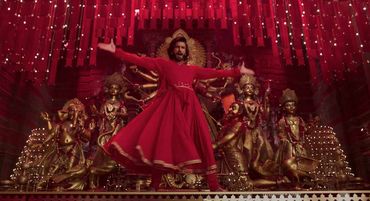My favourite scene in Rocky Aur Rani Kii Prem Kahaani—and it is a film with many amazing moments—is when Ranveer Singh’s Rocky Randhawa emerges from behind Tota Roy Chowdhury’s Chandon Chatterjee, both men performing the highly expressive kathak to ‘Dola Re’. The song, a homage to director Karan Johar’s forever muse Sanjay Leela Bhansali, originally featured Madhuri Dixit and Aishwarya Rai Bachchan. Singh and Chowdhury are not only taking on a herculean task by attempting the incredibly fluid and articulate dance, but they are also competing with two fabulous female dancers.
The two men wear the most well-regarded kathak costumes—a billowing angrakha and churidar—the gender-neutral costume of Mughal India where kathak was the preferred dance form. This is the exact moment when the two men, this sequence, and this film drove home the point that men could do traditionally feminine things and still be themselves.
Contrast this scene with another just less than an hour before. Chowdhury’s Chandon is asked to perform at a traditionally loud Punjabi wedding, where his grace is greeted with embarrassing catcalls instead of a worthy applause. Then, the film grows and we grow up.
As does Ranveer’s Rocky. So easily the most fun part of this hilarious film, Rocky is a Karol Bagh-style newly rich Punjabi who has perfect abs and imperfect English. His “Can you repeat?”, “Escoose me”, and “West Bengal is in west India” are highlighted by his resplendent wardrobe. He would put both Badshah and Diljit Dosanjh to shame wearing only monogrammed clothing—rainbow-hued Gucci, Moncler in Switzerland, a parrot-green Louis Vuitton, a canary-yellow Versace robe, a starry denim suit by Amiri, and I know I saw a DSquared jacket somewhere, too. Once he begins to understand the cultural nuances of his Bengali hosts, he learns Rabindra Sangeet and kathak, and starts wearing more Indian clothes.
Perhaps the most important upshot of this film is its portrayal of men. Rocky moves from brawny masculinity to cultured dignity. Chandon is a dancer and a dance teacher in a household full of strong feminist women. And Dharmendra’s Papaji, cuckolded for all his adult life, finds a voice and his legs (he literally gets off his wheelchair singing ‘Abhi na jao chod ke’) when he finds his long-lost lover. Rocky Aur Rani is a prem kahani, a love story, of men with their own dark shadows, wherein they are told to let go of ‘manliness’ and find their softer edges. Masculinity is not manliness, respect is.
This is also the story of the filmmaker Karan Johar, so easily the most ‘open’ celebrity of our times. Johar has long pushed the envelope for dressing like a peacock. Like Ranveer, his colours and monograms are his armour. His non-masculinity has invited jibes on his sexuality. He offers generous hints, but insists it is his business alone. He says he would dance the heroine’s part of Bollywood songs as a child, not unlike Chowdhury. He had two children through surrogacy, and loves making reels with his tots in his wardrobe. He says he hopes for a late-life lover, like Dharmendra in the film. He is as tied to his family and as woke as Alia Bhatt is in the film.
Audiences have loved Rocky Aur Rani, as have most critics. With this film, both have also understood, accepted and opened their arms to Karan Johar. But most importantly, the film has brought about a major mainstream cultural moment, where the real ‘hero’ of the film is the breakaway from the myth of masculinity.


